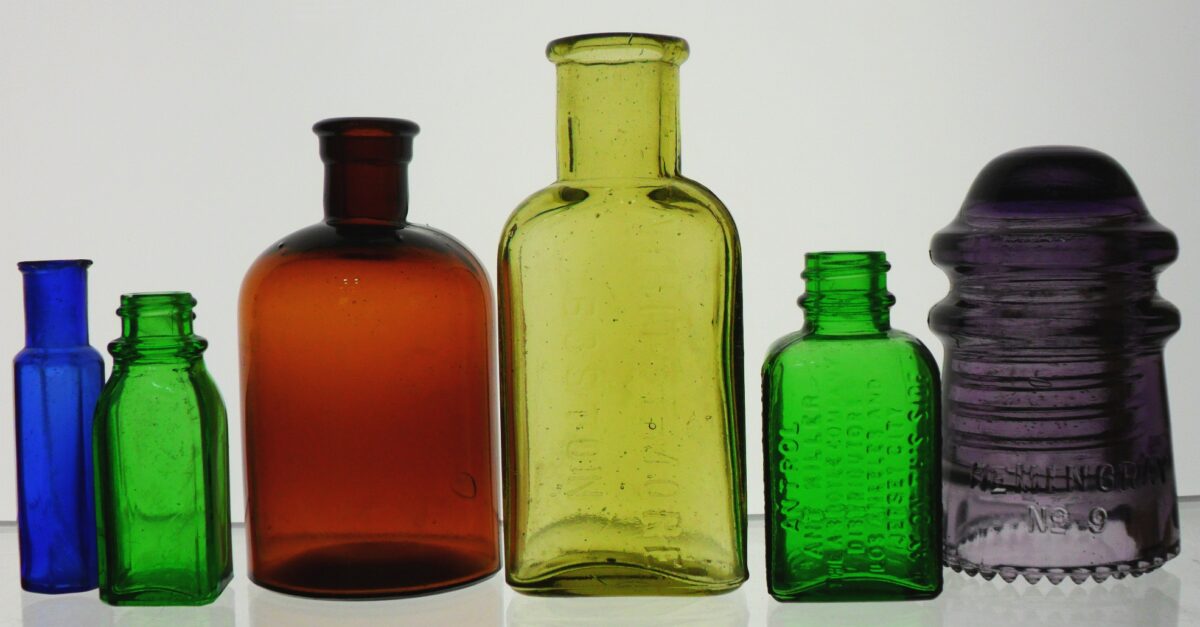Antique Glass Target Balls: Victorian-era handblown hollow glass balls for trap-shooting, eventually replaced by the “Clay Pigeon”
Charles Portlock of Boston, Massachusetts is credited with introducing the glass target ball to the United States (from England) in about 1866. Exactly how long they had already been in use in England seems a little uncertain. There is conflicting information found online on exactly when they were used for the very first time. Most of the earliest target balls are said to have been plain with little or no ornamentation on them.
But glass target balls gradually gained popularity in the US and in 1877 Captain Adam Henry Bogardus (1834-1913), who was born in Berne, New York and later lived much of his life in Elkhart, Indiana, introduced his own patented spring trap (ball-throwing contraption), along with round glass balls with his name and patent date (April 10th 1877) embossed on them. The Bogardus balls featured a quilted or “crosshatch” type of pattern that made the balls more likely to shatter when hit by a bullet. (On plain types with a smooth, round surface, the bullet would sometimes merely glance off without actually breaking the target ball). Several molds were used to produce the Bogardus balls. One type is lettered “BOGARDUS GLASS BALL PATd APR 10, 1877.” Another one is embossed “BOGARDUS GLASS BALL PATd APR 10TH 1877.” The Bogardus balls are found in a wide range of colors. The popularity of the Bogardus balls took off, and soon many balls of various colors and embossings were being produced and sold by other companies. Another popular type was lettered “IRA PAINE’S FILLED BALL PAT OCT 23 1877“. The heyday of glass target ball shooting seems to have been from around 1877 to 1883.
The most prolific glass factory known to have made large numbers of target balls was the firm of Agnew & Brown, of Pittsburgh, in business from 1879 to c. 1882. They were the manufacturers of the very rare “Pigeon ball” that bears an embossed image of a pigeon along with the company name and address. They were probably the primary (if not the only) manufacturer of the Bogardus target balls. (See “Glasshouses and Glass Manufacturers of the Pittsburgh Region 1795-1910” by Jay Hawkins, 2009, page 14).
More information on the “Pigeon ball” and Agnew & Brown can be found here:
https://fohbcvirtualmuseum.org/galleries/target-balls/agnew-brown-pigeon/
There were also certainly other glassmakers that produced target balls but the identity of most of those companies is uncertain. The Kentucky Glass Works Company of Louisville did produce one, with only one example known to exist in collections.

Some examples of colorful Bogardus target balls:
About 1880 the clay pigeon was introduced and the glass ball soon started to fall out of favor, although some production of glass target balls evidently continued (but in much, much smaller quantities) into the late 1910s or possibly early 1920s. The glass balls were often used in popular “Wild West” shows in the very early years of the 20th century.
Target balls are sometimes misidentified as old Christmas ornaments or glass fishing net floats.
(Another type of antique blown glass ball is the lightning rod ball that was used as decoration on lightning rods. Lightning rod balls are often found on the roofs of farmhouses and barns throughout the Midwest that date from the late 1800s and early 1900s).
The typical target ball measures about 2.5 inches in diameter. Target balls are increasingly difficult to find. Sometimes they were saved from destruction and used later as Christmas ornaments. Target balls are occasionally found by, or end up in the possession of, collectors who have no idea what they are. On a rare occasion, an example might show up at a flea market or antique shop.

Target balls usually have a circular rough-edged “lip” or “neck” extending outward where the ball was “cracked off” from the glassblower’s blowpipe. The edge of the glass lip is normally somewhat jagged or irregular.
Target balls are found in a wide array of colors, including many shades of amber, blues, purple, various shades of green, aquamarine and other colors. Clear and aqua balls were rarely made, since they would be more difficult to see against the blue sky. As mentioned above, some are “quilted” with an embossed “cross-hatch” or “waffle” design, and others may be smooth with no raised design on the surface. A few have markings, for instance, lettering that promotes a sporting–goods supply company, or, in a very few instances, the name of a glass manufacturing company.
ADVERTISEMENT
History of Glass Target Balls:
https://traphof.org/artifacts/history-of-glass-target-balls
Here’s a good target ball site, with lots of photos and info: https://targetballs.com/about.php
Here is an auction catalog showing a large number of target balls and related shooting “go-with” collectibles, from the collection of Ralph Finch. (This is a .pdf file). This auction occurred in the 2017-2019 time period and the catalog serves as a valuable archive to a great collection of very rare and seldom-seen items. This also included an overview on antique target balls and some history on them: American Glass Gallery Auction
For an alphabetical list of glass manufacturer markings and logos found on glass bottles, jars, insulators, tableware and other types of glassware, please click on the link here, which points to the Glass Bottle Marks pages (Page One).
Please click here to go to my website Home Page.
ADVERTISEMENT

